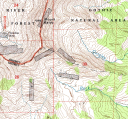Every day of the last week I have climbed the same mountain, bringing up cargoes of steel nails, aluminum tags, meter tapes, string, sandwiches, water, and everything else needed to install a long-term plant census site. The hike in is three miles and climbs from 9000′ to 11700′, rising from subalpine meadows through spruce forest to an alpine scree field.
Here’s what the installation process looks like. First, assembling equipment. I have fifty plots at the site, and each needs its corner points to be permanently marked. Each plant in each plot needs a permanent tag. This means lots of aluminum strips and metal nails hammered into the ground. A recycling shed provides much of the raw materials – then backpack-manageable quantities of metal are stowed in a pack and hiked up the mountain.
At the site, I lay out meter tapes to designate baselines for census plots.
Then metal nails go into the ground to demarcate each plot, and nylon string is laid to mark plot boundaries. The string will probably be destroyed overwinter from ultraviolet radiation or animal nibbling, but it can easily be replaced. I’m more worried about frost heaving destroying the corner makers.
This is the final layout. Each plot is four square meters in area and includes a wide alley so I can walk through the site without trampling the delicate vegetation.
Next up is the census. Each plant gets its own permanent tag, nailed into the ground near its rooting point. I am mapping, sizing, and tagging every individual in every plot. It means a lot of tags, and a lot of nails.
I’m a little over half finished with the initial census. Some plots are bare, and some have more than a hundred individuals. Some are less than a half centimeter tall and others form a low mat covering almost a square meter. They are all beautiful.
The field days are long and hard, but I don’t mind. If the site survives the winter, the science will be good. If it doesn’t, I will try again. In the meantime I am enjoying the scenery.
(Thanks to Guadalupe Flores and Jordan Stark for their invaluable field assistance).










